



CENTRAL RAILROAD OF NEW JERSEY
The CNJ was basically divided into two separate routes. The mainline ran from the Hudson River waterfront in Jersey City to Scranton, PA. The other line went south to the very southern part of New Jersey near Bridgeton. The CNJ also operated the New York & Long Branch to Bay Head Jct.
This page now contains well over 200 images, allow some time for the thumbs to load up and enjoy!
To visit the Southern Division Page, Click here To visit the North Jersey Coast Line Pages, click here
This page will focus on the mainline. After 1967, the CNJ abandoned their terminal in Jersey City and all passenger trains were rerouted to the former PRR station in Newark.
We will begin at the site of the old terminal on the waterfront in Jersey City.
After the terminal was abandoned, it sat empty and vandalized for many years until the area became part of the Liberty State Park. The main terminal was renovated, however the trainsheds remain untouched. The large engine terminal with its huge concrete coaling tower was completely removed and the Liberty Science Center sits on that location.


 3062 in March 1972, Photo courtesy Paul Carpenito.
3062 in March 1972, Photo courtesy Paul Carpenito.
We now move down to Bayonne. The CNJ served many industries in this area, however most are long gone. At the lower end of the Bayonne peninsula near 8th Street, the tracks swung west to cross Newark Bay.
The Bayonne scoot at West 8th Street station. The Jersey Central maintained a local shuttle from Cranford to Bayonne after the 1967 abandonment of the Jersey City terminal.

 The Bayonne shuttle passing 'Shore'
tower. Shore was on the east end of the bridge.
The Bayonne shuttle passing 'Shore'
tower. Shore was on the east end of the bridge.
Various 'scoots' stopping at the Elizabethport station. The east-west mainline was crossed by the Newark branch to the north and the line south to Perth Amboy, later commonly known as the Chemical Coast secondary.


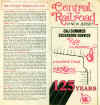
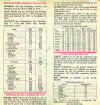 In
1974, the CNJ resurrected the through Raritan to Bay Head train known as the
'Mermaid'. This train ran over the bridge to Bayonne and then reversed
direction and swung south to Perth Amboy and the North Jersey Coast Line.
Having an engine on each end expedited the reverse move. Air-conditioned
'Jersey Builder' cars were used for this service. Here the train is
stopping briefly on the connector track. This track was used by trains
between Jersey City and the NJCL before the 'Aldene' plan took effect in 1967.
In
1974, the CNJ resurrected the through Raritan to Bay Head train known as the
'Mermaid'. This train ran over the bridge to Bayonne and then reversed
direction and swung south to Perth Amboy and the North Jersey Coast Line.
Having an engine on each end expedited the reverse move. Air-conditioned
'Jersey Builder' cars were used for this service. Here the train is
stopping briefly on the connector track. This track was used by trains
between Jersey City and the NJCL before the 'Aldene' plan took effect in 1967.
Elizabethport was the main locomotive and car shop for the railroad.


 Several units at the sanding tower.
Several units at the sanding tower.



 CNJ used several SW-1's for local switching service. The 8405 is a former
B & O unit.
CNJ used several SW-1's for local switching service. The 8405 is a former
B & O unit.
Later EMD switchers in the new red scheme and the old drab olive green.
Coach 974 was not upgraded in the rebuild program that allowed push-pull operation. The CNJ purchased the former Susquehanna RDC cars when that road quit passenger service. 559 is one of them. The old Rock Island car was bought for parts and remained in E'Port for many years.
 Note the Newark Bay bridge and Shore tower in the distance.
Note the Newark Bay bridge and Shore tower in the distance. 
 These three images courtesy of Mr. Paul Carpenito. Paul has allowed many
of his slides to be presented on this page. Thanks, Paul.
These three images courtesy of Mr. Paul Carpenito. Paul has allowed many
of his slides to be presented on this page. Thanks, Paul.

 The CNJ leased two RS-3's from Precision National for a time in 1973 and
1974.
The CNJ leased two RS-3's from Precision National for a time in 1973 and
1974.



 They also purchased a few ex-Reading RS-3's in March 1974 and were
numbered 1533, 1534 and 1535.
They also purchased a few ex-Reading RS-3's in March 1974 and were
numbered 1533, 1534 and 1535.
After the Conrail takeover in 1976, the E'Port shops served the new NJ Transit as a diesel repair facility for several years until the new Meadowlands complex was completed in the late 1980's. An interesting collection of units could always be found there.
 Following the closure of the shops, the building sat
vacant for a few years before being torn down.
Following the closure of the shops, the building sat
vacant for a few years before being torn down.
2503 and 3067 enter the yard from the Newark branch.
 Ex-Reading 1562 uses the wye track as a switching lead.
Ex-Reading 1562 uses the wye track as a switching lead.
 CY tower controlled the CNJ Newark branch crossing of the PRR Greenville
branch. If you look in the very upper right corner of the picture you can
see the hump tower for the LV Oak Island Yard. That's the NJ Turnpike over
top of everything.
CY tower controlled the CNJ Newark branch crossing of the PRR Greenville
branch. If you look in the very upper right corner of the picture you can
see the hump tower for the LV Oak Island Yard. That's the NJ Turnpike over
top of everything.

 Brills yard is on the Newark Branch. The Naprano Scrap yard is here and
many a diesel met its demise there.
Brills yard is on the Newark Branch. The Naprano Scrap yard is here and
many a diesel met its demise there.
 The CNJ had a modest station of their own on Broad St. in Newark. It is
still there today!
The CNJ had a modest station of their own on Broad St. in Newark. It is
still there today!
Back to the Elizabethport Yard.
 SW-1
1012 is assigned to a work train.
SW-1
1012 is assigned to a work train.  Crane 251m.
Crane 251m.  1563 in the yard.
1563 in the yard.


 A few Bayonne shuttles at Elizabeth Station.
A few Bayonne shuttles at Elizabeth Station.  1995, how sad it is.
1995, how sad it is.
 2508 eastbound. Photo courtesy Paul Carpenito
2508 eastbound. Photo courtesy Paul Carpenito
Elmora Avenue station in Elizabeth. Sadly, all the track is removed and the right-of-way is a sea of weeds and trees.
 Roselle Park station was on the westbound side
Roselle Park station was on the westbound side  Roselle is on the eastbound side.
Roselle is on the eastbound side.
After April 1, 1967, all passenger trains originated out of Penn Station in Newark.
3671, RDC cars, 3675 and repainted 5910 at Newark Penn Station. CNJ mainline trains generally used track 5.
 A westbound local for Raritan passes Hunter Tower and will climb up the
connecting track to the LV main. Back when the Lehigh Valley ran their own
passenger trains, they used this ramp to access the PRR. A short stretch
overhead wire on the track up to LV allowed GG-1's to change engines with LV
diesels. The PRR Waverly yards are to the right.
A westbound local for Raritan passes Hunter Tower and will climb up the
connecting track to the LV main. Back when the Lehigh Valley ran their own
passenger trains, they used this ramp to access the PRR. A short stretch
overhead wire on the track up to LV allowed GG-1's to change engines with LV
diesels. The PRR Waverly yards are to the right.
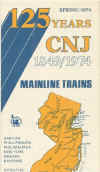 A public timetable issued in
1974 for the 125th anniversary of the CNJ.
A public timetable issued in
1974 for the 125th anniversary of the CNJ.
Trains operated over the Lehigh Valley from Hunter tower to Aldene.
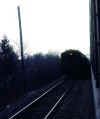 Meeting an eastbound on the LV mainline near Union.
Meeting an eastbound on the LV mainline near Union.
 1524 near Townley on the Lehigh Valley.
1524 near Townley on the Lehigh Valley.
 In an image from 1969, a new GP40P 3671 is
pulling several old green coaches through Hillside.
In an image from 1969, a new GP40P 3671 is
pulling several old green coaches through Hillside.
 Another image from 1969 finds GP7 1530 westbound on the LV at the present location of
Union, NJ station. The two 1969 and 1524 photos courtesy of Paul Carpentino.
Another image from 1969 finds GP7 1530 westbound on the LV at the present location of
Union, NJ station. The two 1969 and 1524 photos courtesy of Paul Carpentino.

 3681 pushes a train toward Newark up the Aldene
ramp.
3681 pushes a train toward Newark up the Aldene
ramp.
Excee tower controlled movements through the Cranford Jct area. A modest yard was located here to serve the connection with the Staten Island Rapid Transit line ( a B & O operation !) and the old Rahway Valley Railroad.
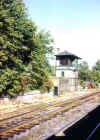 Excee Tower (formerly called XC, hence the name)
Excee Tower (formerly called XC, hence the name)  The operator on duty, 1974.
The operator on duty, 1974.
 New Years Day, 1976.
New Years Day, 1976.  Ex-Reading 1565 is assigned to the small Cranford Yard.
Ex-Reading 1565 is assigned to the small Cranford Yard.
 1531 and an SD35 sit in the yard, 1972
1531 and an SD35 sit in the yard, 1972
 An old FM switcher drills some cars
An old FM switcher drills some cars

 Two eastbound trains passing Excee tower.
Two eastbound trains passing Excee tower.
 Five
images from Paul Carpenito.
Five
images from Paul Carpenito.
 A group of E8's enroute to Raritan for storage
following the closure of the E'Port shops.
A group of E8's enroute to Raritan for storage
following the closure of the E'Port shops.

 As late as 1974, there were
still six tracks through the Cranford station. The outside tracks were
usually used for the Bayonne shuttle.
As late as 1974, there were
still six tracks through the Cranford station. The outside tracks were
usually used for the Bayonne shuttle.




 Cranford action from 1974 to 1976.
Cranford action from 1974 to 1976.

 This train used the outside track for its stop and then backed up to Excee to
crossover to the main running track
This train used the outside track for its stop and then backed up to Excee to
crossover to the main running track
The move was due to the deteriorating condition of track one west of here.
The only way to avoid heading west on track one meant backing to
Excee to use the cross-overs and then head west on track three.
 Following this move a local road drill with 1563 comes through.
Following this move a local road drill with 1563 comes through.
 Cranford station from a 1960 photo. A few things
have changed.
Cranford station from a 1960 photo. A few things
have changed.


 An eastbound early NJT train approaches Cranford.
An eastbound early NJT train approaches Cranford.
 This small station was located in the small town of Garwood.
This small station was located in the small town of Garwood.
 CLARK tower was just east of Westfield.
CLARK tower was just east of Westfield.

 Westfield Station.
Westfield Station.  This small news kiosk is on the westbound side.
This small news kiosk is on the westbound side.

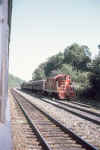
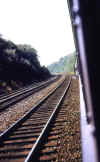
 On board a westbound meeting other trains. I sure
miss those open window cars !!
On board a westbound meeting other trains. I sure
miss those open window cars !!




 Some trains on the Fanwood Curve.
Some trains on the Fanwood Curve.
 Today, New Jersey Transit operates the CNJ
main as far as High Bridge. Thankfully, NJT has chosen to restore or sell
the original buildings intact. Most of the stations on the CNJ remain in
very good condition.
Today, New Jersey Transit operates the CNJ
main as far as High Bridge. Thankfully, NJT has chosen to restore or sell
the original buildings intact. Most of the stations on the CNJ remain in
very good condition.


 A pair of RDC's covering a weekend local make a rather
smoky departure from Fanwood.
A pair of RDC's covering a weekend local make a rather
smoky departure from Fanwood.
 Netherwood Station, Plainfield, NJ. 1974
Netherwood Station, Plainfield, NJ. 1974  Meeting westbound 681
Meeting westbound 681
 Located just east of the Plainfield station was 'Queen'
tower. Named after New Jersey's queen city, Plainfield. The tower
controlled the crossovers and the entrance to the small yard. The freight
house still remains today, as well as, the tower.
Located just east of the Plainfield station was 'Queen'
tower. Named after New Jersey's queen city, Plainfield. The tower
controlled the crossovers and the entrance to the small yard. The freight
house still remains today, as well as, the tower.
 Plainfield
Plainfield  Looking east. You can see 'Queen' in the distance.
Looking east. You can see 'Queen' in the distance.
 A former Reading RS-3 works some industry on Plainfield's west side.
A former Reading RS-3 works some industry on Plainfield's west side.
 3068 eastbound by Plainfield. Courtesy Paul Carpentino
3068 eastbound by Plainfield. Courtesy Paul Carpentino
 This neat little station was at Grant Ave. in Plainfield.
This neat little station was at Grant Ave. in Plainfield. 


 Nicknamed the 'Railroad Town', Dunellen has this modern looking station that was
built in the late 1950's.
Nicknamed the 'Railroad Town', Dunellen has this modern looking station that was
built in the late 1950's.

 This open area is in the town of Middlesex, NJ. The LV mainline is just to
the right.
This open area is in the town of Middlesex, NJ. The LV mainline is just to
the right.
 Eastbound Conrail freight PYSE on the CNJ at the Cedar
Avenue grade crossing. 1-25-81.
Eastbound Conrail freight PYSE on the CNJ at the Cedar
Avenue grade crossing. 1-25-81.
A favorite location on the CNJ main is Bound Brook. Here the Lehigh Valley passes directly behind the eastbound station building and it allowed easy access for photos of both railroads. Today the companies are different, but it is still a very busy place.
 A common daylight eastbound was LE-2
A common daylight eastbound was LE-2 


 A photo from 1963. Photographer unknown.
A photo from 1963. Photographer unknown.  ES-99 with Erie Lackawanna power.
ES-99 with Erie Lackawanna power.
Mr. Paul Carpentino has graciously allowed me to include some of his photos from the Bound Brook area. Images scanned from original slides and are used with his permission.
 GP7 1527 is westbound with a local passing through
Middlesex, NJ, March 1973
GP7 1527 is westbound with a local passing through
Middlesex, NJ, March 1973
 1526 in a drab green color
1526 in a drab green color  1530 in the B&O blue scheme
1530 in the B&O blue scheme  RS-3 1547
RS-3 1547
 1525 in new 'Red Baron' paint, 1974
1525 in new 'Red Baron' paint, 1974  1526 is on passenger run passing LV
214
1526 is on passenger run passing LV
214  1552.
1552.
 1527 with an early morning rush hour train, August 1974.
1527 with an early morning rush hour train, August 1974.
 All red power here in 1973.
All red power here in 1973.
 Big time action in 1972
Big time action in 1972  Also in 1972, 3067 is eastbound with train AJ-2.
Also in 1972, 3067 is eastbound with train AJ-2.
 2510 is eastbound with LE-2
2510 is eastbound with LE-2  3067 now in red paint is westbound with EL-1
3067 now in red paint is westbound with EL-1
 A the first light of day, 2506 works
EL-1
A the first light of day, 2506 works
EL-1  B&O train 682 with a B&O GP40 for power.
B&O train 682 with a B&O GP40 for power.



 More images of Bound Brook in the 1970's
More images of Bound Brook in the 1970's
 This shot tells it all. A westbound freight, a local waiting and a LV
eastbound approaching on the left.
This shot tells it all. A westbound freight, a local waiting and a LV
eastbound approaching on the left.
 In
this image, 1531 is actually on Reading tracks having exited the Central at
Bound Brook Jct. Today, the track under the train seen here has been
removed. The remainder of the track up to the former crossing of the
Lehigh Valley is used for loading trash.
In
this image, 1531 is actually on Reading tracks having exited the Central at
Bound Brook Jct. Today, the track under the train seen here has been
removed. The remainder of the track up to the former crossing of the
Lehigh Valley is used for loading trash.
Thanks again, Paul
Some additional images from Bound Brook.
 Calco was a small shelter primarily used for the
benefit of Johns-Manville employees. NJT built a newer, larger shelter
here and it is now known as Bridgewater. It is adjacent to the new
Somerset Patriots stadium.
Calco was a small shelter primarily used for the
benefit of Johns-Manville employees. NJT built a newer, larger shelter
here and it is now known as Bridgewater. It is adjacent to the new
Somerset Patriots stadium.

 'Brook' tower was the junction point of the Reading main up from
Philadelphia.
'Brook' tower was the junction point of the Reading main up from
Philadelphia.
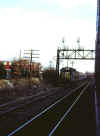 Viewed from an eastbound train is a meet with a westbound local.
Bridgewater, NJ 1974.
Viewed from an eastbound train is a meet with a westbound local.
Bridgewater, NJ 1974.
 The Manville-Finderne station as seen in a 1967 image. Photographer
unknown
The Manville-Finderne station as seen in a 1967 image. Photographer
unknown  Same location 1978.
Same location 1978.


 Somerville, NJ. 3677 image by Tony Koelek.
Somerville, NJ. 3677 image by Tony Koelek.
Somerville was the junction for the
Flemington branch.  Neshanic Station.
Neshanic Station.  Flemington.
Flemington.

 The depot was converted into a bank.
The depot was converted into a bank. 
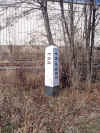 In the middle of the Flemington outlet
In the middle of the Flemington outlet
March 5,
2012
centers is the junction site of the CNJ and the PRR up from
Lambertville. All now operated by the Black River & Western.
 1554 operated on the Black River and Western out of
Flemington. Gary Madden photo.
1554 operated on the Black River and Western out of
Flemington. Gary Madden photo.
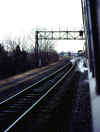
 Boyd tower, Raritan
Boyd tower, Raritan 
 Raritan station. A two track lead for local trains was here, which
resulted in the station being set back from the mainline.
Raritan station. A two track lead for local trains was here, which
resulted in the station being set back from the mainline.
 3061 on LE-2 setting out a car. The two lead tracks heading to the yard
are on the left.
3061 on LE-2 setting out a car. The two lead tracks heading to the yard
are on the left.
Most mainline passenger trains go as far as Raritan.




 GP7's in the 'Red Baron' image.
GP7's in the 'Red Baron' image.
 Former Blue Comet observation car, 1178 was used on the "Farewell to the
CNJ" special.
Former Blue Comet observation car, 1178 was used on the "Farewell to the
CNJ" special.
 RDC 556 waits for its
next trip to Newark.
RDC 556 waits for its
next trip to Newark. 



 3067 leads ES99 west
around a temporary track in 1974.
3067 leads ES99 west
around a temporary track in 1974.
 3061 is westbound with
train EL-1pausing for orders.
3061 is westbound with
train EL-1pausing for orders.  An eastbound 1976 Conrail freight does the same.
An eastbound 1976 Conrail freight does the same.
A few miscellaneous shots in the yard at Raritan

 The CNJ never owned E8 units, but NJT bought several
old PC units and they were painted at Raritan. NJT stored many old
units at Raritan for several years pending disposition to the New Jersey Museum
of Transportation. Despite much talk, the museum has never gotten started
and much of the irreplaceable equipment sits rusting away near Ridgefield Park.
The CNJ never owned E8 units, but NJT bought several
old PC units and they were painted at Raritan. NJT stored many old
units at Raritan for several years pending disposition to the New Jersey Museum
of Transportation. Despite much talk, the museum has never gotten started
and much of the irreplaceable equipment sits rusting away near Ridgefield Park.
Some passenger trains continued west of Raritan to either High Bridge, Hampton or Phillipsburg. Freights west of Raritan included ES99/SE98 to High Bridge and then up the branch to Lake Jct, JH-1/HJ-2 to Harrisburg via the Reading and EL-1/ LE-2 which worked the High Bridge branch and served as a local east to Elizabethport.
 Located off Interstate Highway 78 in Clinton is a
restaurant where the former Blue Comet observation car 'Monmouth' remains
today. This view is from 1973 when the car had just arrived.
Located off Interstate Highway 78 in Clinton is a
restaurant where the former Blue Comet observation car 'Monmouth' remains
today. This view is from 1973 when the car had just arrived.
At North Branch the main crossed the Raritan River on a nice stone arch bridge.
Next station is Whitehouse Station. The beautiful depot remains today.

 Train LE-2 is passing the
station.
Train LE-2 is passing the
station.  The tower stood just east of the station.
The tower stood just east of the station.
 Lebanon was the home of the High Iron Company for many
years.
Lebanon was the home of the High Iron Company for many
years.
 2506 with EL-1 passes under I-78.
2506 with EL-1 passes under I-78.
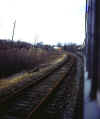 Approaching Annandale Station.
Approaching Annandale Station.  Annandale.
Annandale. 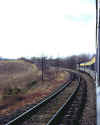 Heading toward High Bridge.
Heading toward High Bridge.
The next main station was High bridge. Named after the railroad bridge that was once just east of the station (now a high fill ), High Bridge is the point where the branch to Lake Jct. and Green Pond Jct. left the main. Once used to reach the Lackawanna and the Susquehanna, as well as, local business in Morris County, the branch became an integral part of the through freight service to Scranton. Following the CNJ pullout from Pennsylvania in 1972, a run-through freight was established with the Erie-Lackawanna utilizing the branch to reach Lake Jct.
ES-99 with 3067 EL-1 with 2503 Several views of ES-99
Here are a few shots of train EL-1 on the branch in 1975.
 Califon.
Califon.  Long Valley.
Long Valley. 
 Bartley.
Bartley.

 GP7 1531 sits in the small yard at High Bridge which
formed a wye between the main and the branch. 1531 was one of the units
that went into Newark Bay back in 1958. It was originally 1526.
Three units were renumbered following the wreck. This was the last GP7
still in the old olive green colors by the end of the CNJ. 1975
photo.
GP7 1531 sits in the small yard at High Bridge which
formed a wye between the main and the branch. 1531 was one of the units
that went into Newark Bay back in 1958. It was originally 1526.
Three units were renumbered following the wreck. This was the last GP7
still in the old olive green colors by the end of the CNJ. 1975
photo.
The last through freights west of High bridge were JH-1 and HJ-2. These trains were operated in conjunction with the Reading to maintain a connection via Allentown.
 Reading units were common on this train. Since
the crews were Reading crews based in Harrisburg, the westbound train would
usually make much better time since they were headed home.
Reading units were common on this train. Since
the crews were Reading crews based in Harrisburg, the westbound train would
usually make much better time since they were headed home.
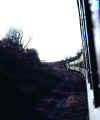 The train is approaching the top of the hill near Hampton. December 18,
1974.
The train is approaching the top of the hill near Hampton. December 18,
1974.

 2507 is bringing train
JH-1 west passing the remains of the Hampton Station. This station was
built to Lackawanna plans as they had a branch to Hampton that came down from
Washington, NJ.
2507 is bringing train
JH-1 west passing the remains of the Hampton Station. This station was
built to Lackawanna plans as they had a branch to Hampton that came down from
Washington, NJ.

 In 1977, Conrail ran a ballast extra west with two
ex-PC units and 1531. Hampton Yard.
In 1977, Conrail ran a ballast extra west with two
ex-PC units and 1531. Hampton Yard.
 In 1982, a fan trip was
run from Newark to Allentown, PA using a trio of former PC E8 units. A
runby was done at Hampton.
In 1982, a fan trip was
run from Newark to Allentown, PA using a trio of former PC E8 units. A
runby was done at Hampton.
 The burned out remains of the Ludlow-Asbury station.
The burned out remains of the Ludlow-Asbury station.
In 1974, the State of New Jersey funded an extension of the Hampton trains out to Phillipsburg. Two consists usually sat out the weekend on the old eastbound main track. A mid-day train ran Monday to Friday.
 Here is the train I rode on December 18, 1974. It was the midday roundtrip
and spent about 20 minutes here.
Here is the train I rode on December 18, 1974. It was the midday roundtrip
and spent about 20 minutes here.


 The service lasted into 1982 before retrenching back to
High Bridge. 1982 images.
The service lasted into 1982 before retrenching back to
High Bridge. 1982 images.
 The station
at Phillipsburg was a joint CNJ and DL & W station. The
Lackawanna is on the left.
The station
at Phillipsburg was a joint CNJ and DL & W station. The
Lackawanna is on the left.
 'PU' Tower in 1974. This view looks west toward
Easton, PA. The old semaphore signals protected the Lackawanna junction,
the crossing of the LV-PRR interchange track and the approach to the L &HR junction just over the Delaware River
Bridge. Today the tower still stands and the main is now Norfolk
Southern.
'PU' Tower in 1974. This view looks west toward
Easton, PA. The old semaphore signals protected the Lackawanna junction,
the crossing of the LV-PRR interchange track and the approach to the L &HR junction just over the Delaware River
Bridge. Today the tower still stands and the main is now Norfolk
Southern.  Phillipsburg was supposed to be the location of a railroad
museum, but this is now very much in jeopardy as a housing developer wants the
land slated for the museum ( what else is new ! ). As of October
2009, the tower is undergoing a restoration !
Phillipsburg was supposed to be the location of a railroad
museum, but this is now very much in jeopardy as a housing developer wants the
land slated for the museum ( what else is new ! ). As of October
2009, the tower is undergoing a restoration !


 Easton, PA
station. It burned in 1974. This spot remains vacant today.
Easton, PA
station. It burned in 1974. This spot remains vacant today.
The main from Easton to Bethlehem was quickly abandoned after the CNJ pulled out of Pennsylvania in 1972.

 The station at Bethlehem remains in near perfect condition even today.
October 25, 2009.
The station at Bethlehem remains in near perfect condition even today.
October 25, 2009.
 This
old LNE plow sat in Bethlehem for years.
This
old LNE plow sat in Bethlehem for years.
 3068 leads two other SD40's on an eastbound out of Allentown yard.
Photographer unknown ( P ).
3068 leads two other SD40's on an eastbound out of Allentown yard.
Photographer unknown ( P ).

 Bethlehem engine house, 1970. Photos courtesy Gary Madden ( GM ).
Bethlehem engine house, 1970. Photos courtesy Gary Madden ( GM ).
 A few old Norfolk & Western cab units on the engine
house lead ( P ).
A few old Norfolk & Western cab units on the engine
house lead ( P ).


 Even after the pullout from Pennsylvania, CNJ units could be found here.
Usually off B & O run-throughs.
Even after the pullout from Pennsylvania, CNJ units could be found here.
Usually off B & O run-throughs.


 The CNJ operated portions of the former Lehigh and New
England from 1961 to the end in 1976. Here a train is headed to Tadmor
passing through Bath, PA. March 17, 1974.
The CNJ operated portions of the former Lehigh and New
England from 1961 to the end in 1976. Here a train is headed to Tadmor
passing through Bath, PA. March 17, 1974.
 RSD-4 1605 at Tadmor. Photo is by the late George Berisso, a fine
gentleman who left us much to soon.
RSD-4 1605 at Tadmor. Photo is by the late George Berisso, a fine
gentleman who left us much to soon.

 RS3 1703 and an RSD4 are working the hump lead.
1970 images. GM.
RS3 1703 and an RSD4 are working the hump lead.
1970 images. GM.

 Two views of RS3 and RSD4 paired units assigned to the hump. Photographers
unknown ( P ). Let me note here, several images in this area are from
original slides I purchased over the years. Since I hold the original
slides I am presenting them for your enjoyment only. Thank you for not
copying or reprinting them. As noted on the bottom of this page, all
images should not be used for any purpose without permission.
Two views of RS3 and RSD4 paired units assigned to the hump. Photographers
unknown ( P ). Let me note here, several images in this area are from
original slides I purchased over the years. Since I hold the original
slides I am presenting them for your enjoyment only. Thank you for not
copying or reprinting them. As noted on the bottom of this page, all
images should not be used for any purpose without permission.
 3067 in its pre-Timpany red color, leads a westbound past 'R' tower on the west
end of Allentown yard. (P)
3067 in its pre-Timpany red color, leads a westbound past 'R' tower on the west
end of Allentown yard. (P)


 A forlorn looking station in Allentown in 1975.
The building was fixed up and remains today. It sits on the west side of
the Lehigh River near the LV main. CNJ passenger trains went through the
yard ( which is on the east side of the river ) and used Reading tracks over the
river to 'BURN' where a branch went off to reach the station. The Reading
had tracks coming off their main at 'BURN' for trains heading to or from
Reading. CNJ trains continuing to Scranton went along the LV main and then
crossed over the river between Catasaqua and Allentown on a small bridge which
is still there today.
A forlorn looking station in Allentown in 1975.
The building was fixed up and remains today. It sits on the west side of
the Lehigh River near the LV main. CNJ passenger trains went through the
yard ( which is on the east side of the river ) and used Reading tracks over the
river to 'BURN' where a branch went off to reach the station. The Reading
had tracks coming off their main at 'BURN' for trains heading to or from
Reading. CNJ trains continuing to Scranton went along the LV main and then
crossed over the river between Catasaqua and Allentown on a small bridge which
is still there today.
On April 1, 1972 the CNJ ceased to operate its mainline in the state of Pennsylvania as a cost cutting move. Almost all of its lines were thereafter operated by the Lehigh Valley. On March 31, 1972, my good friend Gary Madden took a day off from work to record the last day of the CNJ in Pennsylvania. While this page is oriented in a east to west direction, the final train west of Allentown was photographed going eastbound from Jim Thorpe to Allentown.


 Owing to a derailment near Glen Onoko, the last train out of Scranton operated
over the LV down to Lehighton. Here it is passing the site of the former
LV passenger station at Jim Thorpe. More on the CNJ side here below.
Owing to a derailment near Glen Onoko, the last train out of Scranton operated
over the LV down to Lehighton. Here it is passing the site of the former
LV passenger station at Jim Thorpe. More on the CNJ side here below.
 After passing through Packerton yard, the train regained CNJ rails at Lehighton
tower. This interesting view looks westward from the LV main. Other
than the remains of the fill that once carried the CNJ main over top of the LV,
little remains here today. The LV main where Gary was standing is now a
highway, the bridge is gone, but the Norfolk Southern still operates the former
CNJ main from Allentown.
After passing through Packerton yard, the train regained CNJ rails at Lehighton
tower. This interesting view looks westward from the LV main. Other
than the remains of the fill that once carried the CNJ main over top of the LV,
little remains here today. The LV main where Gary was standing is now a
highway, the bridge is gone, but the Norfolk Southern still operates the former
CNJ main from Allentown.
 Ducking under the Route 148 bridge nearing Hazards.
Ducking under the Route 148 bridge nearing Hazards. 

 Passing through the Lehigh Gap. The remains of the old Lehigh and New
England right-of-way are visible up on the mountain.
Passing through the Lehigh Gap. The remains of the old Lehigh and New
England right-of-way are visible up on the mountain.
 Coming around the big sweeping curve west of Treichlers.
Coming around the big sweeping curve west of Treichlers.  Treichlers.
Treichlers.
 Finally, the 'hospital' train approaches Allentown. Many thanks to Gary
for sharing these historic photos.
Finally, the 'hospital' train approaches Allentown. Many thanks to Gary
for sharing these historic photos.


 Siegfried station is on the north side of Northampton, a
few miles north of Allentown.
Siegfried station is on the north side of Northampton, a
few miles north of Allentown.
 Palmerton, PA is just north of the Lehigh Gap.
Palmerton, PA is just north of the Lehigh Gap. 
 'HX' tower is at the east end of the very complex trackage surrounding the old New
Jersey Zinc plant here at Palmerton. Smoke and pollution from this plant
killed off almost every tree on the north side of Blue Mountain. Now that
it is shut down, some new growth has begun.
'HX' tower is at the east end of the very complex trackage surrounding the old New
Jersey Zinc plant here at Palmerton. Smoke and pollution from this plant
killed off almost every tree on the north side of Blue Mountain. Now that
it is shut down, some new growth has begun.
 Viewed from a restaurant on top of Flagstaff Mountain sits Jim Thorpe, PA. GM
Viewed from a restaurant on top of Flagstaff Mountain sits Jim Thorpe, PA. GM

 Jim Thorpe station, March 31, 1972. GM
Jim Thorpe station, March 31, 1972. GM


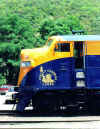 Two ex-Bangor and Aroostook F3 units were purchased by the the Anthracite
Railway Historical Society and were repainted into the beautiful original blue
and yellow Jersey Central colors. They operated in short tourist trips
from Jim Thorpe for a few years.
Two ex-Bangor and Aroostook F3 units were purchased by the the Anthracite
Railway Historical Society and were repainted into the beautiful original blue
and yellow Jersey Central colors. They operated in short tourist trips
from Jim Thorpe for a few years.
For a look at today's Reading and Northern's Lehigh Gorge trains, Click
here.
 Going under the Route 93 bridge
Going under the Route 93 bridge  Passing the old turntable at Jim Thorpe. Note 1554 in green and gold
paint.
Passing the old turntable at Jim Thorpe. Note 1554 in green and gold
paint.
 Going through the tree growth that surrounds Neshquehoning Junction.
Going through the tree growth that surrounds Neshquehoning Junction.
 Neshquehoning Junction is where the branch that led over to an interchange with
the Reading left the mainline. Many a coal train came down off this
branch. It is still in use today by the Reading and Northern! This
view, looking east, is from the last day, March 31, 1972. GM.
Neshquehoning Junction is where the branch that led over to an interchange with
the Reading left the mainline. Many a coal train came down off this
branch. It is still in use today by the Reading and Northern! This
view, looking east, is from the last day, March 31, 1972. GM.
 1972
1972  1974
1974  1982 'PQ' tower at Neshquehoning Jct.
1982 'PQ' tower at Neshquehoning Jct.
 The mainline crossed over the Lehigh River and the LV main. Looking back
east toward the tower. May 1974.
The mainline crossed over the Lehigh River and the LV main. Looking back
east toward the tower. May 1974.

 Just south of Wilkes-Barre is the town of Ashley. Famous at one time for
the Ashley Planes, the CNJ still maintained a small yard and facility here until
the end. Two images from 1982 show the rather modern looking yard tower
and the old roundhouse still standing.
Just south of Wilkes-Barre is the town of Ashley. Famous at one time for
the Ashley Planes, the CNJ still maintained a small yard and facility here until
the end. Two images from 1982 show the rather modern looking yard tower
and the old roundhouse still standing.
 Wilkes-Barre station in 1973.
Wilkes-Barre station in 1973.  The tracks are gone, but the station was restored.
The tracks are gone, but the station was restored.

 Scranton Station. 1973 and 1982. It is still there.
Scranton Station. 1973 and 1982. It is still there.  The small yard office. 1973.
The small yard office. 1973.
 Finally, one last image from Pennsylvania, although a
bit off line. In November 1975, a derailment on the Erie Lackawanna at the
Delaware Water Gap ( train SE-98 ) caused SD40 3069 to roll over and burn.
EL SD45 3637 was the other unit also destroyed. The 3069 was eventually
sold to the Norfolk and Western and was made into a slug for use in the Roanoke,
VA yard. Photo is near Portland, PA.
Finally, one last image from Pennsylvania, although a
bit off line. In November 1975, a derailment on the Erie Lackawanna at the
Delaware Water Gap ( train SE-98 ) caused SD40 3069 to roll over and burn.
EL SD45 3637 was the other unit also destroyed. The 3069 was eventually
sold to the Norfolk and Western and was made into a slug for use in the Roanoke,
VA yard. Photo is near Portland, PA.
After the CNJ was absorbed into Conrail on April 1, 1976, many changes took place. The mainline eventually was sold to New Jersey Transit and is almost exclusively a passenger line. High Bridge is as far west as they go now. The track remains in place as far as Bloomsbury where as connector track was built to reach the former LV main. With the construction of I-78, the mainline was severed between Bloomsbury and Phillipsburg. Due to the defective LV bridge over the Delaware River, Conrail moved their freight main over to the CNJ tracks through Phillipsburg. The main from Phillipsburg to Allentown was removed early, but the Allentown yard continues to be major hub for Norfolk Southern. The main from Allentown to Lehighton is in use and west of there it is a mix of former Lehigh Valley and CNJ trackage to Wilkes-Barre.
One nice touch that NJT has done is to apply the red Jersey Central Lines logo to replacement bridges being installed along the CNJ main. Two plaques are on the new bridge over Route 206 between Somerville and Raritan.
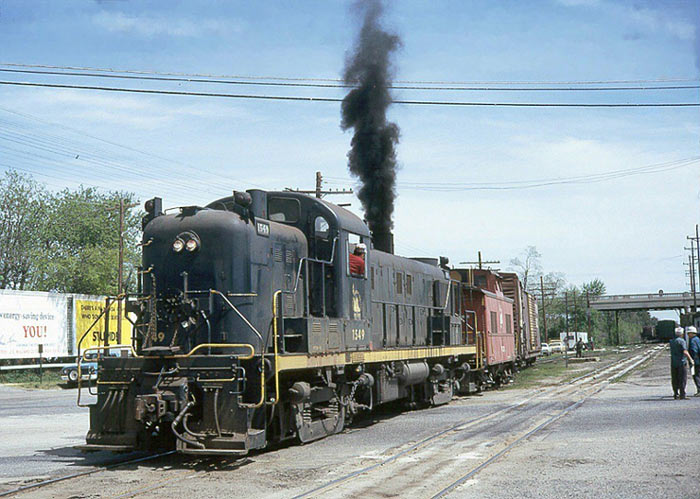 Click here for the Southern Division !
Click here for the Southern Division !
 Click here for the North Jersey Coast Line
page
Click here for the North Jersey Coast Line
page
ALL PICTURES ARE COPYRIGHTED AND MAY NOT BE REPRODUCED FOR DISTRIBUTION WITHOUT PERMISSION. ALL IMAGES ARE NOT TO BE SOLD FOR ANY REASON
THANK YOU FOR YOUR COOPERATION. ROBERT A. STAPLES